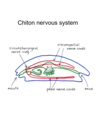Polyplacophora Flashcards
What is the dorsal view of chitons dominated by?
8 shell valves and mantle
Describe the ventral view of chitons
Head: knob with mouth
Foot: muscular, clings to rocks
Anus
Osphradia (sensory)

Explain how the chiton clings to rocks
- It uses its muscular foot to attach to substrate
- A chiton can use muscular action to change the pressure inside the pallial cavity, and this creates suction to stick it to the substrate
Where are the ctenidia located? How many are there?
In the pallial cavity: the space between the foot and the girdle
There are two, located in the pallial cavities on either side of the chiton.
Describe the cross section of a chiton

What are the dorsal and ventral sides called?
ventral: cephalopodium
dorsal: visceropallium
Describe hemolymph flow through the ctenidia

Are the digestive tract and gonad contained in a eucoelomic compartment?
No, it is a hemocoel. It is a space in the in the connective tissue not lined by epithelium, like a true coelomic compartment would be.
What does the true coelom form in chitons?
The pericardium- the cavity around the heart.
What are the components of the digestive tract
- Mouth
- Buccal cavity
- Radular cartilages
- Radular sac
- Stomach with digestive gland
- Intestine
- Anus

What secretes the radula?
The radular sac
What is the radula used for? Is this the ancestral or derived form of this action.
- Used for feeding-scraping algae off rocks
- This is the ancestral form
Describe how feeding works in chitons
- Cartilage extruded (is covered w radular ribbon) and presses against rocks
- Protraction and retraction of radular teeth scrapes it along rock
What is the chiton’s nervous system composed of?
- Circumpharyngeal nerve ring
- Visceropallial nerve chords
- Pedal nerve chords (near foot)

What are 5 distinct characteristics of chitons and reasons behind them?
- Minimal cephalization: don’t move rapidly
- Dorso-ventral flattening: resist wave action
- Dorsal shell as 8 pieces: shell valves move relative to each other to cling to rocks
- Mantle assists with adhesion: A chiton can use muscular action to change the pressure inside the pallial cavity, and this creates suction to stick it to the substrate
- Radula with magnetite caps


